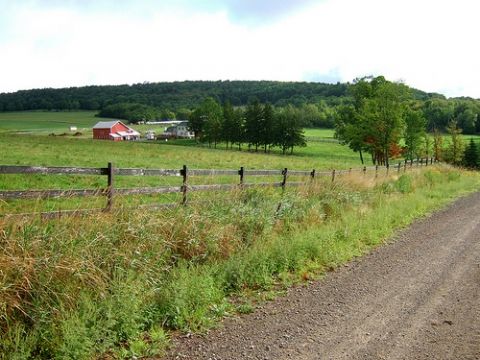
Rural enough for ya? Photo of dirt road in the Delaware County town of Meredith by Flickr user somervillebikes; shared in the Watershed Post's Flickr group.
A newly-released report from the U.S. Department of Agriculture recommends a change in the agency's definition of "rural," a shift that would make larger towns newly eligible for a variety of USDA grants.
The new definition, if adopted, would replace several different definitions currently used in different USDA grant programs with a single criterion: To be considered "rural," a community must have less than 50,000 people.
Under the old definitions, to be eligible for community water and waste disposal grants and loans, a community could have no more than 10,000 people. For community facility grants and loans, the upper limit was 20,000 people.
In today's Daily Yonder, an online news site devoted to rural issues, writer Aleta Botts -- an agriculture policy expert and former aide to rural Minnesota congressman Collin Peterson -- argues that the new definition will pit tiny rural communities against their larger neighbors. By opening up the competition for a shrinking pool of USDA grants, Botts writes, the agency is tilting the playing field against the smallest towns:
USDA argues that regional initiatives will blossom once the population limit is lifted, since smaller communities will work with larger nearby communities – all of whom will now be eligible – and greater cooperation will be achieved, since the entire system will be eligible for funding. However, what incentive will larger communities have to work with smaller communities when those larger areas will now be eligible for grants and low-interest loans regardless of whether they develop an integrated system or not?
The USDA report issued Friday mirrors the Senate’s version of the farm bill, passed by that chamber last year but which never made it through the House. Senate Agriculture Chair Debbie Stabenow commended the agency for their report for addressing an issue “that has long frustrated small town mayors and other members of rural communities.” However, which small-town mayors are more troubled by multiple definitions of rural than by efforts to allow larger, more developed neighboring communities to squeeze out the applications of smaller locales?
A complex point system for evaluating potential projects does give communities extra points for being smaller and more rural. But, Botts argues, those are outweighed by other criteria that could favor larger towns, and communities who can afford to hire professional grantwriting staff.
Peterson, Botts's former boss and the ranking member of the House Agriculture Committee, is also worried about the new definition. Farm Futures reports that Peterson and Agriculture Committee chairman Frank Lucas of Oklahoma issued a joint statement decrying the USDA's proposed change:
House Agriculture Committee Chairman Frank Lucas and Ranking Member Collin Peterson said Monday that while they were appreciative of the information contained in the report, they were "disappointed" in USDA's proposals to shift funding away from the most rural areas by inflating the definition across the board.
"This will result in smaller communities competing with larger and more urban areas for funding," the lawmakers said. "In an increasingly tight fiscal environment, careful targeting of scarce funding is critical to ensuring the communities who should benefit from these programs are given priority."
To see the importance of the USDA's rural development grant programs to small towns, look no further than the Greene County town of Ashland -- population 784, as of 2010. Last year, a $2.8 million USDA funding package paid for most of the cost of replacing the hamlet of Ashland's contaminated water supply. The Windham Journal's Michael Ryan describes how dire Ashland's water situation was:
Water has been so nasty in the hamlet area over the years, containing multiple bad elements, that it would corrode home appliances and hot water tanks lickety-split.
Fire trucks, if washed in the stuff, would rust right in front of your eyes and it is more than local legend that the liquid coming out of the tap could literally be ignited.
The town made numerous attempts to remedy the situation, drawing up plans and making local residents dream only to leave them disappointed due to a shortage of money.
No one wanted to go deeply in debt, borrowing the necessary funding, and while there will be some debt incurred it is two million dollars less than it could have been, officials emphasize.
Can a town the size of Ashland compete with a town like Catskill (pop. 11,775) or Kingston (pop. 23,887), both of which would be newly eligible to apply for community water infrastructure grants under the proposed definition? For the USDA -- whose grantmaking capacity was already being squeezed by budget cuts even before the sequester loomed -- it's a fair question.
Below: The USDA's report recommending a new definition of "rural" for the agency's programs. For more materials attached to the report -- including some that the agency has not yet publicly released -- see this page on the Daily Yonder's website.
Rural Definition Report - USDA by Watershed Post












